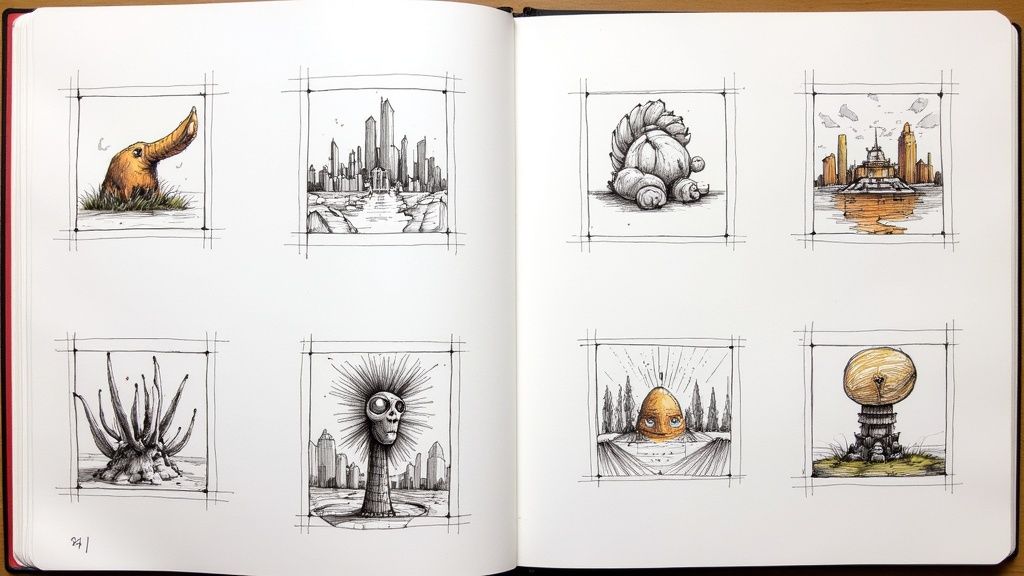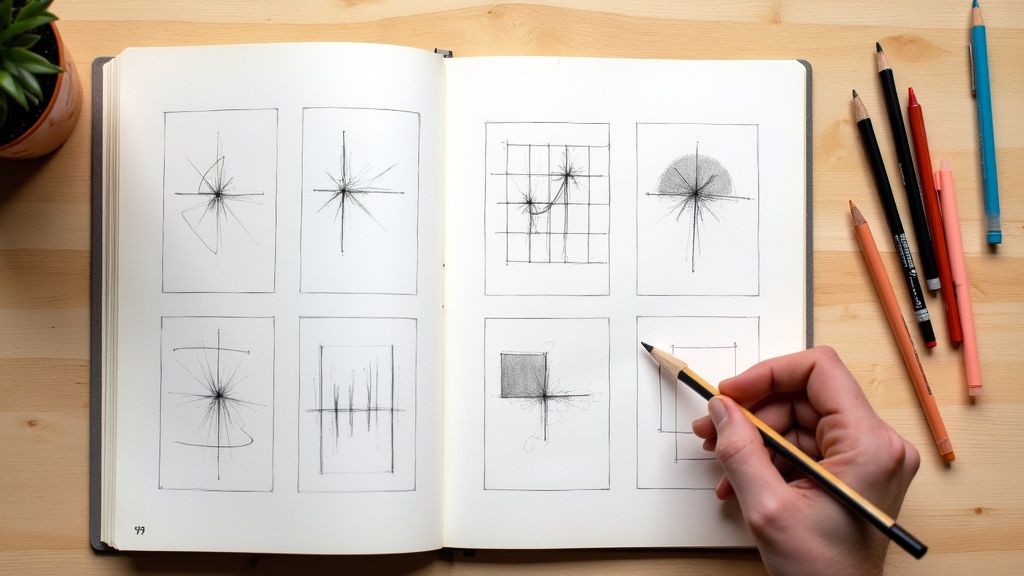Have you ever scrolled through social media, seen an irresistibly cute illustration, and thought, 'I wish I could draw that'? The good news is, you can! The world of cute art isn't reserved for seasoned professionals; it's built on simple shapes, charming expressions, and techniques anyone can master. This guide is your starting point for creating delightful sketches that bring a smile to your face. We're moving beyond generic advice to give you specific, actionable steps for a variety of popular styles.
Whether you're filling a sketchbook, looking for a relaxing hobby, or want to add a personal touch to your projects, these cute drawings easy enough for complete beginners will boost your confidence and ignite your creativity. Forget the pressure of perfection and get ready to have fun with just a pen and paper. We will explore eight different styles, each broken down into simple, manageable instructions to help you start drawing immediately. From kawaii animals and chibi characters to charming food with faces and simple doodle cats, you'll find plenty of inspiration to get you started. This list is designed to provide clear, practical tips that make drawing accessible and enjoyable for everyone, regardless of skill level.
1. Kawaii Animals
The term "kawaii" is a Japanese cultural concept that directly translates to "cute," and applying it to art creates some of the most charming and cute drawings easy enough for any beginner. Kawaii-style animals are instantly recognizable by their distinct proportions: oversized heads, small bodies, and large, expressive eyes that radiate innocence. This style intentionally simplifies complex animal anatomy into basic, soft geometric shapes, making it an incredibly accessible entry point for new artists.
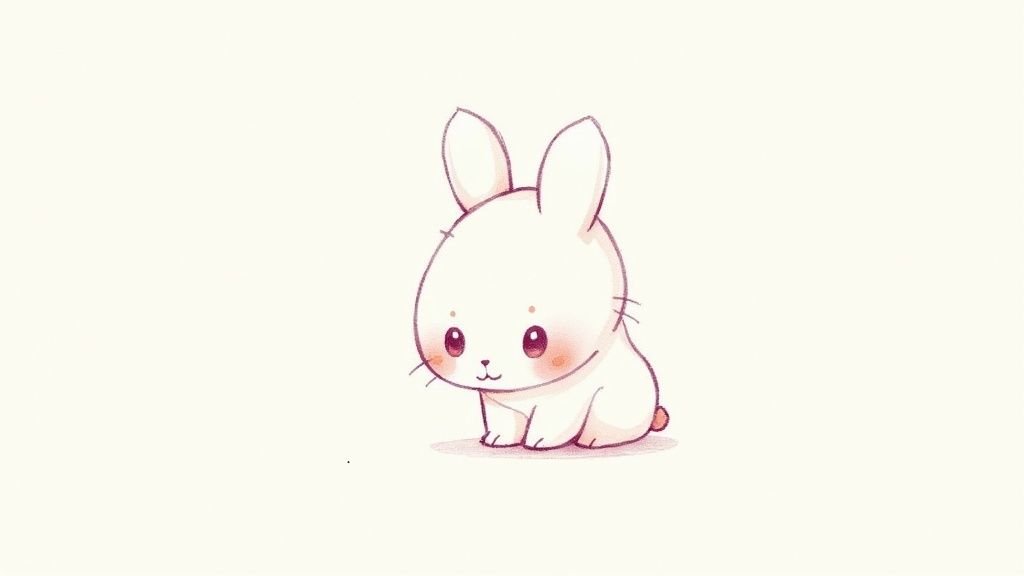
The charm of kawaii art lies in its formulaic approach to cuteness. By following a few simple rules, you can transform almost any animal into an adorable character. Think of iconic examples like Sanrio's Hello Kitty or the viral sensation Pusheen the Cat. These designs prove that simplicity, when combined with specific proportions, creates a powerful and universally appealing aesthetic. This makes it an ideal style for creating stickers, greeting cards, or just fun doodles.
How to Draw Kawaii Animals
To start your own kawaii animal drawing, focus on these core principles. The key is to exaggerate features associated with youth and innocence.
- Start with the Head: Draw a large circle or a rounded square for the head. This will be the main focal point of your drawing.
- Establish the Body: Add a much smaller oval or bean shape for the body directly beneath the head. A good rule of thumb is to aim for a 2:1 head-to-body ratio for maximum cuteness.
- Focus on the Eyes: The eyes are critical. Draw two large circles, placing them far apart and low on the face. These should take up about one-third of the head's total space. Add smaller white circles inside for a sparkly, "shining" effect.
- Simplify Features: Keep the nose and mouth small and simple. A tiny dot or an inverted "v" works for the nose, while a small, curved "w" or a simple line can form the mouth.
- Add Cute Details: Finish with short, stubby limbs and add two pink ovals on the cheeks for blush marks. These small touches significantly enhance the adorable look.
For more inspiration on character design, you can find a variety of cute drawing ideas to practice these techniques.
2. Simple Cartoon Faces
Drawing simple cartoon faces is one of the most fundamental yet rewarding skills for an artist, making it a perfect example of cute drawings easy to master. These drawings rely on exaggerated expressions built from basic shapes like circles, ovals, and simple lines. The core principle is to convey strong emotions through minimal detail, focusing on the eyes, eyebrows, and mouth to tell a story. This approach is incredibly accessible and teaches the essential principles of character design and emotional expression.
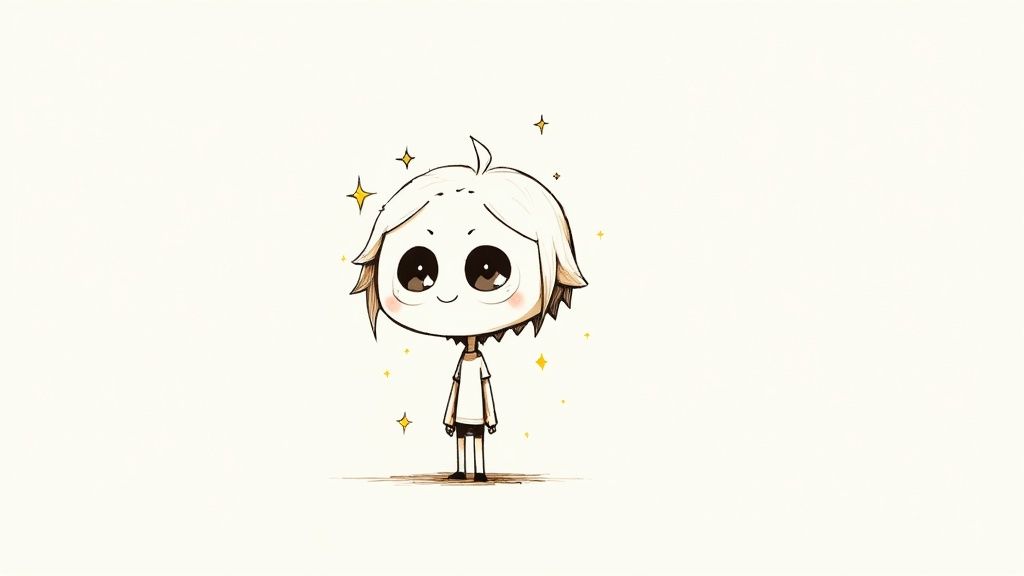
The power of a simple cartoon face is evident everywhere, from modern emoji designs to classic characters like Charlie Brown. Artists like Charles M. Schulz demonstrated that you don't need complex anatomy to create relatable and beloved characters. By mastering a few key combinations of lines and shapes, you can create a wide range of personalities and feelings. This makes it an ideal technique for beginners interested in creating their own characters, webcomics, or custom emoticons.
How to Draw Simple Cartoon Faces
To start drawing your own expressive cartoon faces, focus on how basic elements interact to create emotion. The goal is clear communication through simplified features.
- Start with a Head Shape: Begin with a circle, but don't be afraid to experiment with other shapes like ovels, squares, or even triangles to give your character a unique look. Lightly draw vertical and horizontal guidelines to help with placing the features.
- Define the Eyes: The eyes are the windows to the soul, even in cartoons. Simple dots, circles, or ovals work perfectly. Vary their shape and size to create different personalities; for example, wide-open circles convey surprise, while half-closed lids can show sleepiness or suspicion.
- Use Eyebrows for Emotion: The position of the eyebrows is crucial for expression. Arched eyebrows can show happiness or surprise, while angled-down brows create an angry or determined look. A single, curved eyebrow can express skepticism.
- Create a Simple Mouth: A simple curved line is often all you need. An upward curve creates a smile, a downward curve shows sadness, and a flat line can indicate a neutral or unimpressed feeling. An "o" shape works great for surprise.
- Practice Basic Expressions: Combine these elements to practice the core emotions: happiness, sadness, anger, and surprise. Once you master these, you can start creating more nuanced expressions.
For more inspiration, you can explore a variety of simple and easy drawing ideas to practice different facial constructions.
3. Chibi Characters
"Chibi" is a Japanese term for "small" or "short," and in the art world, it describes a specific style of caricature where characters are drawn in an exaggeratedly cute and childlike form. Creating cute drawings easy is the core appeal of the chibi style, which distorts proportions to make anyone or anything adorable. Instead of realistic 7-8 head-to-body ratios, chibi characters are typically only 2-4 heads tall, giving them a distinct, lovable appearance. This intentional simplification makes even the most complex character designs accessible for artists of all skill levels.
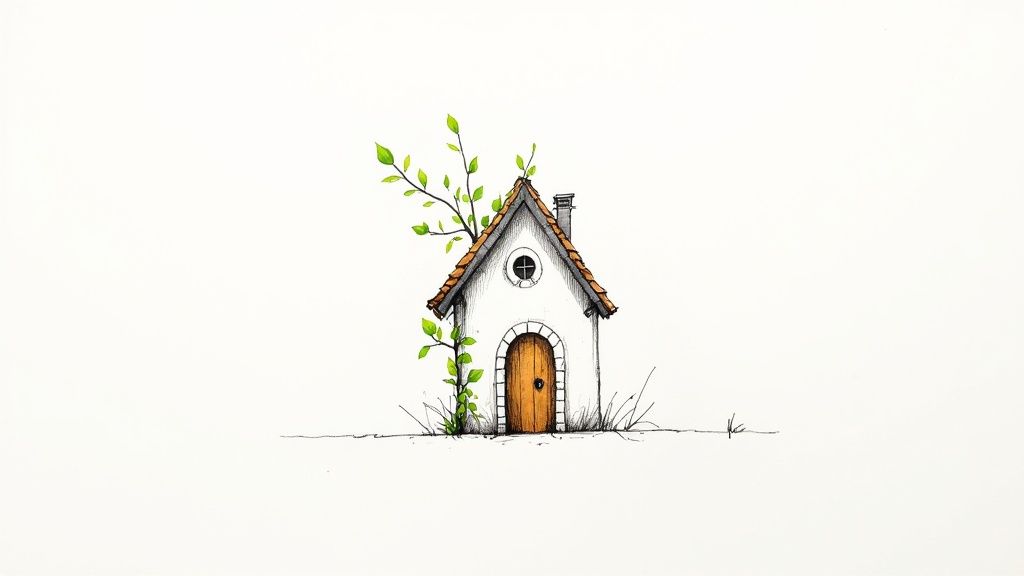
The charm of chibi art comes from its ability to condense a character’s essence into a compact, expressive package. Popularized through anime and manga fan art, this style is now a staple in official merchandise, video games like Animal Crossing, and countless sticker designs. The focus is not on realism but on capturing a character's most recognizable traits and personality in a simplified, super-deformed format. This makes it a perfect style for creating fan art, personalized keychains, or fun digital avatars.
How to Draw Chibi Characters
To master the chibi style, you'll focus on miniaturization and simplifying details while amplifying expression. These core steps will help you transform any character into a cute chibi version.
- Start with a Large Head: Just like with kawaii animals, the head is the star. Draw a large, round shape for the head first, as it will anchor your entire drawing.
- Create a Tiny Body: The body should be roughly the same height as the head, or even slightly smaller, for that classic super-deformed look. A simple pear or bean shape works perfectly.
- Simplify the Limbs: Keep the arms and legs short, stubby, and simple. You can use noodle-like shapes or small ovals for hands and feet, omitting fine details like individual fingers.
- Focus on Key Features: Identify the character's most iconic elements, such as their hairstyle, a signature accessory, or unique eyes, and make them prominent. Simplify everything else.
- Exaggerate Expression: Use large, expressive eyes and an exaggerated mouth to convey personality. A happy character might have a huge, open-mouthed smile, while an angry one could have comically downturned eyebrows.
4. Food with Faces
Transforming everyday snacks into charming characters is a wonderfully creative way to make cute drawings easy and fun. The concept is simple: take any food item, from a strawberry to a slice of toast, and give it a face. This technique personifies the inanimate, creating an instant connection and an endearing result that is popular in everything from social media illustrations to brand mascots.
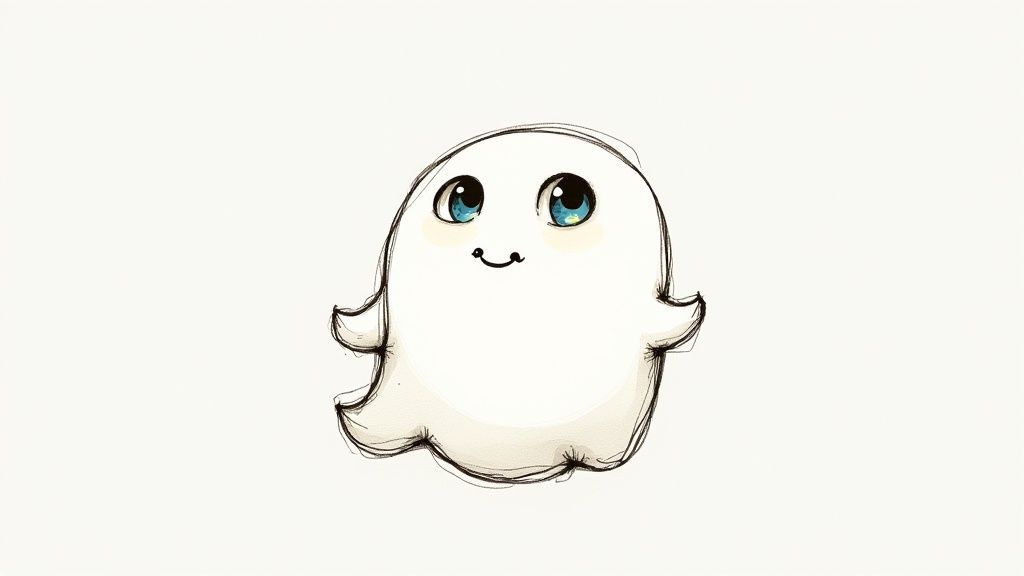
The appeal of food with faces comes from its blend of the familiar with the unexpected. We all know what an apple or a cookie looks like, so adding simple eyes and a smile creates a delightful surprise. This style is heavily influenced by Japanese kawaii culture, especially bento box art where food is styled to look like cute animals or characters. It’s an accessible art form for beginners because the foundational shapes are already defined by the food itself.
How to Draw Food with Faces
Drawing food with faces is a playful exercise in character design. By focusing on simple expressions and details, you can bring any food to life.
- Choose a Simple Food: Start with foods that have a clear, basic shape, like an egg, a banana, or a cookie. These provide a clean canvas for your facial features.
- Position the Face: Place the eyes and mouth on the most prominent or smoothest surface of the food item. This ensures the expression is clear and becomes the focal point.
- Match the Personality: Think about the food's "personality." A fiery chili pepper might have a mischievous grin, while a sweet cupcake could have a happy, content smile. This adds another layer of character to your drawing.
- Keep Features Simple: Use basic dots for eyes and a small curved line for a mouth. As with kawaii animals, simplicity is key to maximizing the cuteness factor.
- Add Small Details: Enhance your drawing by including authentic details like sesame seeds on a burger bun, sprinkles on a donut, or a small stem and leaf on a piece of fruit.
5. Simple Doodle Cats
Simple doodle cats capture the essence of felines using basic shapes and lines, resulting in some of the most charming and cute drawings easy for anyone to master. This minimalist style avoids complex anatomy, instead focusing on key characteristics like pointy triangular ears, long whiskers, and expressive poses. The approach is perfect for beginners because it relies on simple, recognizable forms to create an instantly adorable cat character.
The popularity of doodle cats is fueled by internet culture, from viral cat memes to the work of social media artists like Lingvistov. These illustrations prove that you don't need photorealism to convey personality and emotion. By focusing on a few key lines and shapes, you can easily depict a cat that is sleepy, playful, or curious. This makes the style incredibly versatile for creating stickers, custom greeting cards, or just filling a sketchbook page with fun doodles.
How to Draw Simple Doodle Cats
To create your own simple doodle cat, concentrate on capturing feline characteristics with minimal detail. The goal is expression through simplicity.
- Build the Foundation: Start with two circles, one slightly larger for the head and a connected oval or circle for the body. The placement of these shapes will define the cat's initial pose.
- Add Defining Features: Draw two triangles on top of the head for ears. Make them slightly tilted outward for a more natural and relaxed look. For the face, a small triangle nose and a simple curved "w" or "3" shape for the mouth work perfectly.
- Use Lines for Expression: Add a few long, curved lines on each side of the nose for whiskers. Use simple curved lines for the body to show contentment, or straighter, more rigid lines to suggest alertness or surprise.
- Give it Personality with a Tail: The tail is a powerful tool for expression. A long, elegant "S" curve can show grace, while a poofed-up tail can signal excitement or fear. Experiment with different tail positions to give your cat a unique personality.
For more practice with this relaxed and creative style, you can explore various doodle drawing ideas to expand your skills.
6. Basic Flower Doodles
Basic flower doodles transform intricate botanical structures into simple, elegant shapes, making them some of the most versatile and cute drawings easy for beginners to master. This style relies on simplifying petals, stems, and leaves into foundational geometric forms like circles, teardrops, and curved lines. By focusing on repetitive patterns and clean outlines, you can capture the cheerful essence of a flower without getting bogged down in realistic detail.
The appeal of flower doodles lies in their accessibility and decorative potential. Popularized by bullet journal enthusiasts and hand-lettering artists on social media, these simple designs are perfect for embellishing notebooks, creating custom greeting cards, or even designing tattoo flash sheets. Their charm comes from their handcrafted, organic feel, proving that you don't need complex techniques to create something beautiful and heartwarming.
How to Draw Basic Flower Doodles
To begin drawing your own charming floral designs, concentrate on simple forms and pleasing arrangements. The goal is to suggest a flower rather than replicate it perfectly.
- Start with the Center: Draw a small circle for the core of the flower. This will be your anchor point for the petals.
- Add Simple Petals: Create five or six petals around the center using simple teardrop, oval, or rounded U-shapes. Don't worry about making them perfectly identical; slight variations add character.
- Draw a Curved Stem: Use a single, slightly curved line for the stem to give it a more natural, dynamic appearance instead of a perfectly straight line.
- Include Simple Leaves: Add small leaves along the stem using basic pointed oval or almond shapes. You can add a single line down the middle for a simple vein.
- Group for Composition: When drawing multiple flowers, group them in odd numbers like three or five. This is a classic design principle that creates a more visually appealing and balanced composition.
7. Cute Ghosts and Monsters
Turning traditionally spooky figures into charming characters is a fantastic way to create cute drawings easy for everyone to enjoy, especially around Halloween. Cute ghosts and monsters subvert expectations by swapping scary features for adorable ones. This approach relies on soft shapes, friendly expressions, and whimsical details to make eerie subjects feel approachable and fun, proving that even creatures of the night can be irresistibly sweet.
This style has become incredibly popular, influencing everything from children's Halloween costume designs to seasonal merchandise and social media art trends. Think of the classic sheet ghost, but with big, sparkly eyes and rosy cheeks, or a little monster that looks more like a fluffy pet than a fearsome beast. The goal is to reimagine what "monster" means by focusing on harmless, playful attributes instead of frightening ones.
How to Draw Cute Ghosts and Monsters
Creating your own friendly ghouls is simple when you focus on softness and simplicity over scares. The key is to keep all features rounded and gentle.
- Start with Basic Shapes: For a ghost, begin with a classic wavy or bell-like shape, similar to an upside-down "U." For a monster, a simple circle or fuzzy oval works perfectly for the head and body.
- Focus on Friendly Faces: The face is crucial. Give your character large, expressive eyes. A simple, smiling mouth or a small "o" shape for a surprised look adds instant charm. Avoid menacing or angry expressions.
- Soften Scary Elements: If you want to add traditional monster features like horns or fangs, keep them small, rounded, and non-threatening. Tiny nubs for horns or small, triangular fangs that don't look sharp will maintain the cute aesthetic.
- Add Cute Accessories: One of the easiest ways to boost the cute factor is by adding accessories. A small bow, a tiny top hat, or even having your ghost hold a flower can completely transform its personality.
- Use a Cheerful Palette: Stick to light or pastel colors. While a classic ghost is white, you can experiment with soft pinks, blues, or lavenders. For monsters, bright and cheerful colors work much better than dark, gloomy shades.
8. Simple Heart and Love Doodles
The heart is a universal symbol of love and affection, making it a perfect foundation for some of the most charming and cute drawings easy for anyone to create. Simple heart and love doodles leverage this instantly recognizable shape, transforming it into expressive characters and decorative motifs. This style is incredibly versatile, allowing artists to convey emotions from romance to friendship with just a few simple lines.
The appeal of heart doodles comes from their inherent simplicity and emotional resonance. By adding simple faces, wings, or decorative patterns, a basic heart can take on a life of its own. Think of classic Valentine's Day cards, the heart emojis used in digital communication, or hand-lettered journal entries. These examples show how a simple shape can be adapted to create a powerful and endearing visual, making it ideal for greeting cards, social media posts, or personal notes.
How to Draw Simple Heart and Love Doodles
To begin drawing your own cute hearts, focus on mastering the basic form and then adding personality through simple details. The key is to keep the designs clean and expressive.
- Master the Basic Shape: A great way to draw a symmetrical heart is to start with two equal-sized circles placed side-by-side. Then, draw two lines that slope downwards from the outer edges of the circles, meeting at a point at the bottom.
- Add Personality: Give your heart a face to instantly make it cuter. Add two small dot eyes and a simple curved line for a smile. Experiment with different expressions by changing the shape of the mouth or adding eyebrows.
- Create Visual Interest: Don't just draw one heart. Create a composition by drawing hearts of varying sizes floating together. Overlapping them can create a sense of depth and movement.
- Incorporate Cute Elements: Enhance your doodle by combining the heart with other simple motifs. Add small wings, a halo, a cupid's arrow, or surround it with tiny stars and flowers.
- Practice Different Angles: Try drawing hearts from a slight side view or tilted angle. This adds dynamism to your illustrations and is great practice for developing your skills.
Easy Cute Drawing Styles Comparison
Style | Implementation Complexity | Resource Requirements | Expected Outcomes | Ideal Use Cases | Key Advantages |
|---|---|---|---|---|---|
Kawaii Animals | Low | Basic drawing tools, pastel or simple colors | Cute, simplified animal characters | Social media art, children's books | Beginner-friendly, universally adorable |
Simple Cartoon Faces | Low | Basic sketching tools | Expressive, exaggerated facial emotions | Emojis, mascots, character design | Teaches emotions, quick and satisfying |
Chibi Characters | Low to Medium | Sketching tools, color materials | Cute, miniaturized character designs | Fan art, video game characters | Simplifies complex characters, visually appealing |
Food with Faces | Low | Simple drawing tools, natural color schemes | Relatable, charming food characters | Educational content, social media | Familiar shapes, broad audience appeal |
Simple Doodle Cats | Low | Basic sketching tools | Minimalist, expressive cat illustrations | Memes, social media, greeting cards | Quick to draw, very forgiving |
Basic Flower Doodles | Low | Pens, markers | Decorative, relaxing botanical patterns | Journals, decorations, tattoos | Meditative, versatile decorative use |
Cute Ghosts and Monsters | Low | Basic colors, sketching tools | Friendly spooky characters | Halloween, seasonal art | Kid-friendly spooky, popular seasonal style |
Simple Heart and Love Doodles | Low | Basic drawing tools | Universal love/romance symbols | Cards, social media, gifts | Universally recognized, versatile |
Your Next Steps on the Path to Cuteness
You've just explored a fantastic collection of ideas for cute drawings easy enough for any skill level. From adorable kawaii animals and chibi characters to whimsical food with faces and simple doodle cats, you now have a powerful toolkit to kickstart your artistic practice. The journey from a blank page to a finished piece of art can feel daunting, but as you've seen, every complex drawing begins with the same fundamental building blocks: circles, ovals, and simple lines.
The techniques we've covered are more than just one-off tricks; they are foundational skills. Understanding the 1:1 head-to-body ratio for chibi characters, for example, gives you a formula for creating cuteness on demand. Similarly, mastering simple cartoon faces by focusing on dot eyes and expressive eyebrows unlocks the ability to give personality to literally any object, whether it's a ghost, a flower, or a slice of toast.
Key Takeaways for Your Artistic Journey
Think of this list not as a final destination but as a launching pad. The real magic happens when you start combining these concepts. Why not draw a chibi character holding a tiny, cute ghost? Or create a garden scene filled with simple flower doodles and a few doodle cats peeking from behind the leaves? The possibilities are truly endless.
Remember these core principles as you continue to practice:
- Embrace Simplicity: Cuteness often lies in minimalism. A few well-placed dots for eyes and a simple curve for a smile can convey more emotion than a highly detailed rendering.
- Practice Makes Progress: Don't aim for perfection on your first try. The goal is to fill your sketchbook with attempts. Each drawing, regardless of the outcome, strengthens your muscle memory and builds your confidence.
- Find Joy in the Process: Drawing should be fun! If you feel frustrated with one style, switch to another. The variety of options, from spooky-cute monsters to lovely heart doodles, ensures you can always find something that sparks your interest.
Turning Inspiration into Action
The most significant hurdle for any artist is often the question, "What should I draw next?" This is where consistent, guided practice becomes invaluable. Don't let your newfound skills go unused. The best way to solidify what you've learned is to apply it immediately and repeatedly. Challenge yourself to a "daily doodle" where you tackle one of these cute drawing ideas each day.
Revisit your favorite subjects from this list and see how you can add your own unique twist. Can you design a whole family of food characters? Or perhaps create a lineup of cute monsters with different personalities? The key is to keep your pencil moving and your imagination active. By making drawing a regular habit, you'll be amazed at how quickly your ability to create cute drawings easy and effortlessly improves, transforming from a challenging task into a relaxing and rewarding hobby.
Ready to conquer the blank page for good? If you're looking for an endless supply of creative prompts, the Drawing Ideas Generator from Drawing List is your ultimate tool. With thousands of ideas spanning nearly 100 categories, you'll never run out of inspiration for cute, fun, and exciting sketches. Find your next great idea and keep your artistic journey moving forward at Drawing List.
